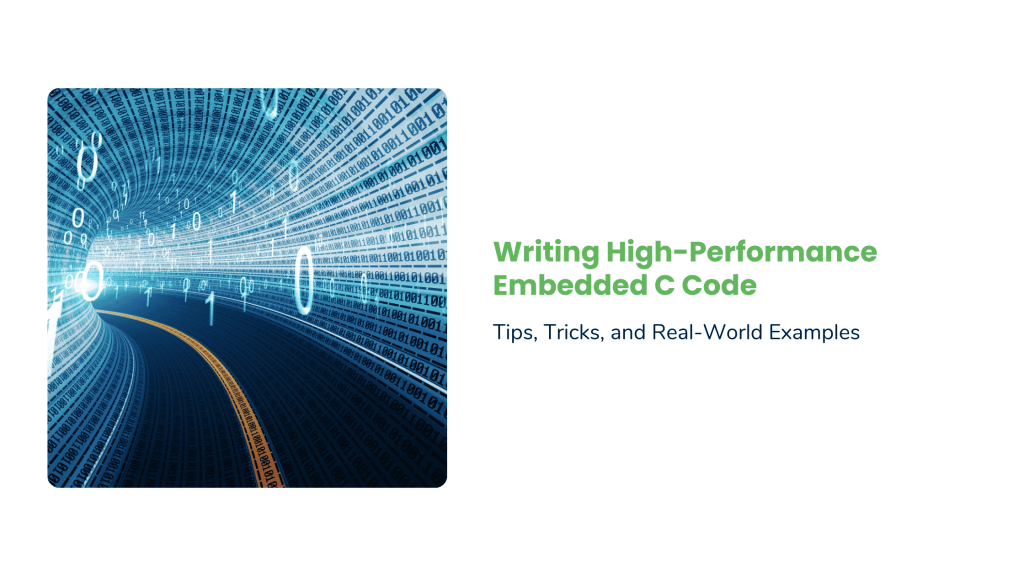Writing High-Performance Embedded C Code: Tips, Tricks, and Real-World Examples

Introduction
Embedded systems often operate under strict performance and resource constraints, making it essential to write efficient and optimized C code. In this blog, we’ll explore practical techniques to improve execution speed, memory usage, and power efficiency with hands-on examples.
-
Optimize Memory Usage
Efficient memory handling is critical in embedded systems where RAM is limited.
Use Fixed-Size Data Types:
![]()
Unsigned Char (unsigned char)
Definition:
unsigned char is an 8-bit data type (1 byte) that holds values from 0 to 255.
Usage in Embedded Systems:
- Memory Efficiency: Used when only small values are needed, reducing RAM usage.
- Portability: Ensures consistent behavior across platforms where char may be signed or unsigned by default.
- Hardware Registers & Buffers: Often used to interface with hardware registers or handle communication buffers.
Example:
unsigned char sensorData = 200; // Example sensor reading
Understanding uint32_t
Definition:
uint32_t is a 32-bit (4-byte) unsigned integer that stores values from 0 to 4,294,967,295.
Why Use uint32_t?
- Fixed-Size Guarantee: Ensures a consistent 32-bit representation across different compilers.
- Performance Optimization: Helps optimize memory usage and performance on 32-bit microcontrollers.
- Interfacing with Hardware Registers: Many microcontroller peripherals use 32-bit registers.
Example:
uint32_t adcReading = 123456789; // Example ADC value
Understanding Bitfields in Embedded C
Definition:
Bitfields allow efficient memory usage by defining a structure where individual bits or groups of bits represent values.
Why Use Bitfields?
- Memory Efficiency: Saves memory by packing multiple fields into a single byte or word.
- Register-Level Programming: Used to map microcontroller hardware registers efficiently.
- Improves Code Readability: Provides a structured way to represent bitwise data
Avoid Dynamic Memory Allocation:
![]()
Heap allocation (malloc/free) can lead to fragmentation and unpredictable behavior.
-
Minimize CPU Cycles with Efficient Loops
Unoptimized loops can consume unnecessary CPU cycles.
Use Loop Unrolling for Small Iterations:
![]()
This reduces loop overhead and improves execution speed.
-
Leverage Compiler Optimizations
Modern compilers offer powerful optimization flags to enhance performance.
Enable Compiler Optimizations (GCC Example):
![]()
-O2 enables aggressive optimizations without significantly increasing code size.
-
Use Volatile for Interrupts & Shared Variables
When dealing with hardware registers and interrupts, use volatile to prevent unwanted compiler optimizations.
![]()
-
Reduce Function Call Overhead
Function calls introduce stack operations that slow execution. For frequently used small functions, use inline.
![]()
This eliminates the function call overhead, inlining the code directly where used.
-
Utilize DMA for Peripheral Communication
Using Direct Memory Access (DMA) offloads CPU workload for data transfers.
Example: Configuring DMA for UART on STM32:
![]()
This frees up CPU cycles while the transfer occurs in the background.
Conclusion
Writing high-performance embedded C code requires careful attention to memory, CPU cycles, and hardware-specific optimizations. Developers can create efficient, fast, and power-optimized embedded applications by applying these techniques.